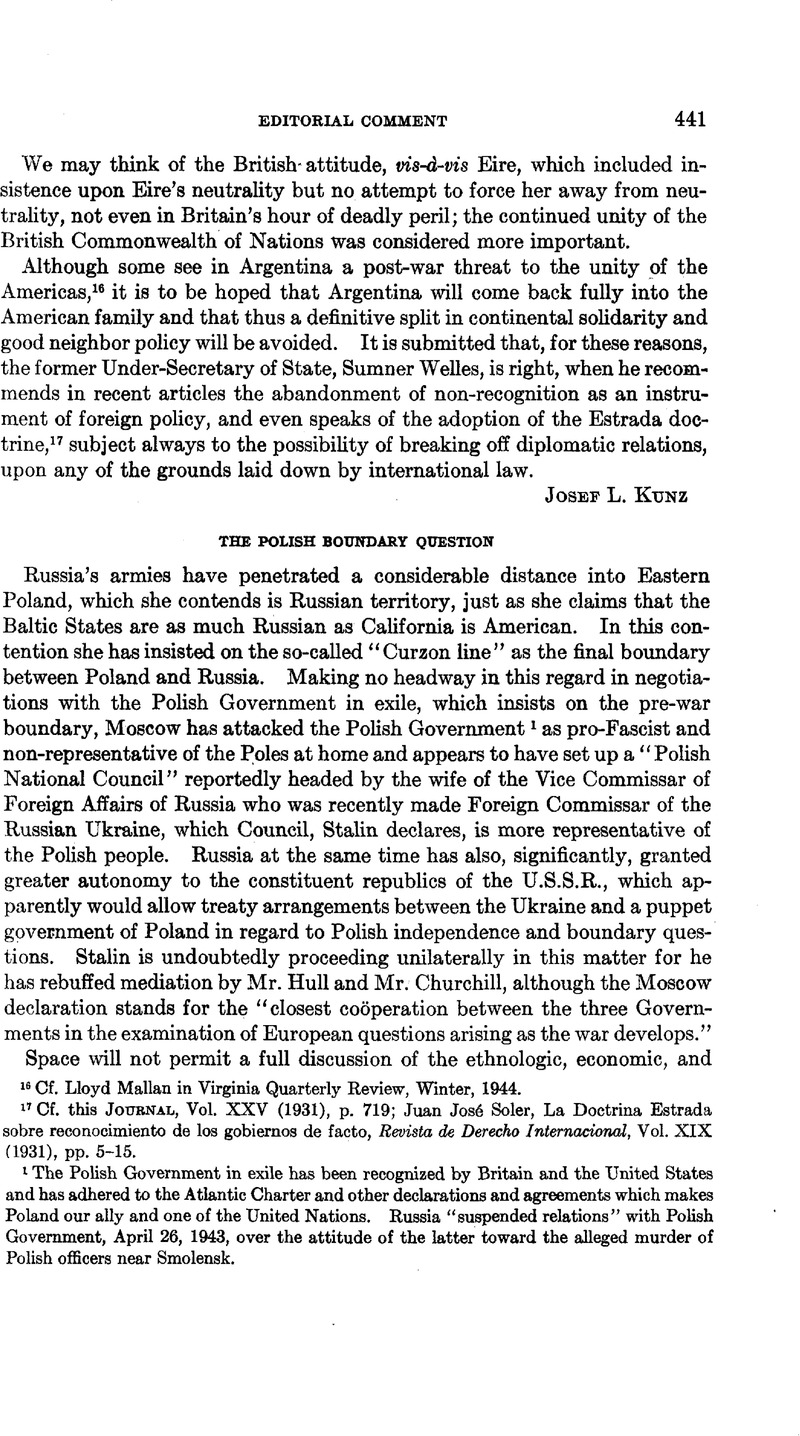No CrossRef data available.
Published online by Cambridge University Press: 25 April 2017

1 The Polish Government in exile has been recognized by Britain and the United States and has adhered to the Atlantic Charter and other declarations and agreements which makes Poland our ally and one of the United Nations. Russia “suspended relations” with Polish Government, April 26, 1943, over the attitude of the latter toward the alleged murder of Polish officers near Smolensk.
2 It appears that the Bolshiviki recognized the independence of Poland in March, 1917 (Polish Handbook, 1925, p. 72).
3 The Ukraine was reconquered by the Red Armies in 1919–20 and in 1923 became a constituent Republic of the U.S.S.R.
4 The plebiscite in Upper Silesia (Art. 88) was held in 1921 and the German-Polish Agreement thereon of May 15,1922, established that piece of the boundary. (Sarah Wam-baugh, Plebiscites Since the World War, p. 26.)
5 Polish White Book, 1933–9, pp. 164–5.
6 It is said that Pilsudski, then Commander-in-Chief of the Polish forces, was a Lithuanian born near Wilno. Newman, The New Europe, pp. 187–190. See generally the excellent work of Sarah Wambaugh, Plebiscites Since the World War, pp. 307 ff.
7 The Pact in part reads as follows:
“Art. 1. The two Contracting Parties, recording the fact that they have renounced war as an instrument of national policy in their mutual relations, reciprocally undertake to refrain from taking any aggressive action against or invading the territory of the other Party, either alone or in conjunction with other Powers.
“Any act of violence attacking the integrity and inviolability of the territory or the political independence of the other Contracting Party shall be regarded as contrary to the undertakings contained in the present Article, even if such acts are committed without declaration of war and avoid all possible warlike manifestations.
“Art. 2. Should one of the Contracting Parties be attacked by a third State or by a group of other States, the other Contracting Party undertakes not to give aid or assistance, either directly or indirectly, to the aggressor State during the whole period of the conflict.
“If one of the Contracting Parties commits an act of aggression against a third State the other Contracting Party shall have the right to be released from the present Treaty without previous denunciation.
“Art. 3. Each of the Contracting Parties undertakes not to be a party to any agreement openly hostile to the other Party from the point of view of aggression.” (Polish White Book, 1933–1939, p. 171.)
8 Same, p. 179.
9 Same, p. 181.
10 The Annex declared that no active aggression could be justified because of “ (a) the internal condition of a state … or (b) the international conduct of a state,” of which examples were given. (Same, pp. 173–4.)
11 Hitler’s demands included a settlement of the Dantzig problem, the Corridor problem, and the problem of German minorities in Poland.
12 The agreement included a Pact of mutual assistance to supplement their non-aggression Pact of September 28,1926. During the negotiation of her demands on Finland in November, 1939, Russia denounced the non-aggression Pact of 1932 and on November 30 Russian troops invaded Finland and bombed Helsinki and Viborg from the air.
13 Dallin, David J., Soviet Russian Foreign Policy, 1939–42, p. 75 Google Scholar.
14 Bulletin of International News, Vol. XVIII, p. 1016. It is understood that thousands of Poles had been seized and deported to Russia during the occupation.
15 Same.
16 British Comd. paper 6315, Misc. No. 3 (1941).